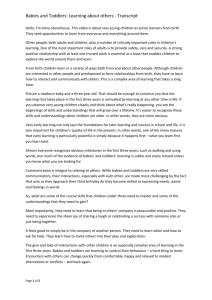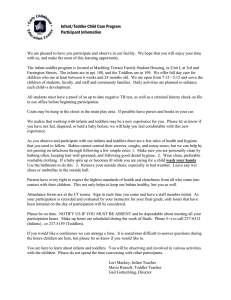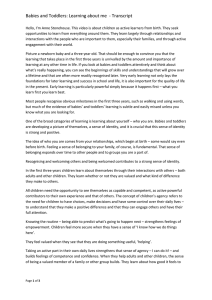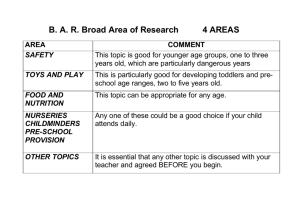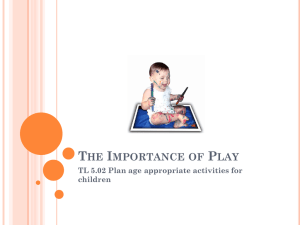Exploring and Thinking
advertisement
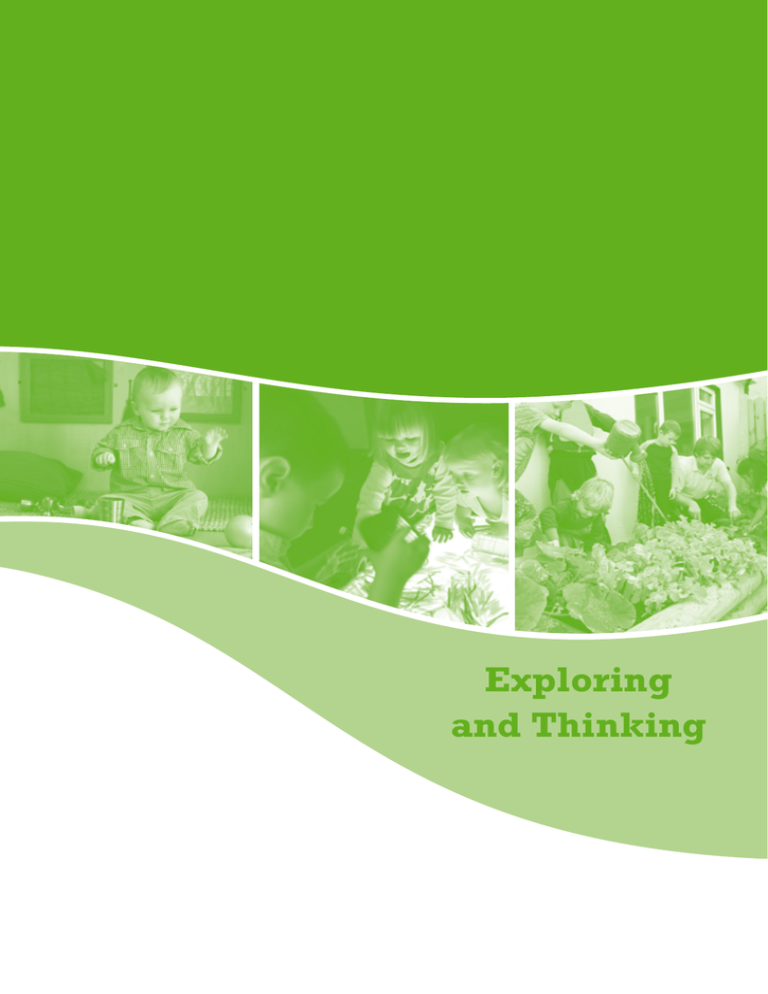
Exploring and Thinking Aistear: the Early Childhood Curriculum Framework Exploring and Thinking Theme: Exploring and Thinking The theme of Exploring and Thinking is about children making sense of the things, places and people in their world by interacting with others, playing, investigating, questioning, and forming, testing and refining ideas. Children use their senses, their minds and their bodies to find out about and make sense of what they see, feel and experience in the world around them. They gather information and develop new skills, including thinking skills. They form ideas and theories and test these out. They refine their ideas through exploring their environment actively and through interacting and communicating with adults and with other children. Much of this happens through play and other experiences that allow children to be creative, to take risks, and to make discoveries. As they learn, they retest their theories adjusting them to take on board new discoveries and new experiences. In early childhood, most children develop physically and cognitively through exploring their environment, though some have disabilities that make this more difficult to achieve. As well as building knowledge and developing skills, children also need to develop positive dispositions and attitudes towards learning. They have an innate drive to get to know the workings of their world. The adult can foster learning by planning activities for them through which they can experience success as learners. This means planning activities that are suited to children’s individual needs and connect with their experiences and interests while at the same time challenging them to extend their knowledge, refine their skills, and work together to solve problems. 43 Aistear: the Early Childhood Curriculum Framework Exploring and Thinking Table 4: Aims and learning goals for Exploring and Thinking Exploring and Thinking Aims Learning goals Aim 1 Children will learn about and make sense of the world around them. In partnership with the adult, children will 1. engage, explore and experiment in their environment and use new physical skills including skills to manipulate objects and materials 2. demonstrate a growing understanding of themselves and others in their community 3. develop an understanding of change as part of their lives 4. learn about the natural environment and its features, materials, animals, and plants, and their own responsibility as carers 5. develop a sense of time, shape, space, and place 6. come to understand concepts such as matching, comparing, ordering, sorting, size, weight, height, length, capacity, and money in an enjoyable and meaningful way. Aim 2 Children will develop and use skills and strategies for observing, questioning, investigating, understanding, negotiating, and problemsolving, and come to see themselves as explorers and thinkers. In partnership with the adult, children will 1. recognise patterns and make connections and associations between new learning and what they already know 2. gather and use information from different sources using their increasing cognitive, physical and social skills 3. use their experience and information to explore and develop working theories about how the world works, and think about how and why they learn things 4. demonstrate their ability to reason, negotiate and think logically 5. collaborate with others to share interests and to solve problems confidently 6. use their creativity and imagination to think of new ways to solve problems. Aim 3 Children will explore ways to represent ideas, feelings, thoughts, objects, and actions through symbols. In partnership with the adult, children will 1. make marks and use drawing, painting and model-making to record objects, events and ideas 2. become familiar with and associate symbols (pictures, numbers, letters, and words) with the things they represent 3. build awareness of the variety of symbols (pictures, print, numbers) used to communicate, and use these in an enjoyable and meaningful way leading to early reading and writing 4. express feelings, thoughts and ideas through improvising, moving, playing, talking, writing, story-telling, music and art 5. use letters, words, sentences, numbers, signs, pictures, colour, and shapes to give and record information, to describe and to make sense of their own and others’ experiences 6. use books and ICT (software and the internet) for enjoyment and as a source of information. Aim 4 Children will have positive attitudes towards learning and develop dispositions like curiosity, playfulness, perseverance, confidence, resourcefulness, and risktaking. In partnership with the adult, children will 1. demonstrate growing confidence in being able to do things for themselves 2. address challenges and cope with frustrations 3. make decisions and take increasing responsibility for their own learning 4. feel confident that their ideas, thoughts and questions will be listened to and taken seriously 5. develop higher-order thinking skills such as problem-solving, predicting, analysing, questioning, and justifying 6. act on their curiosity, take risks and be open to new ideas and uncertainty. 44 Aistear: the Early Childhood Curriculum Framework Exploring and Thinking Sample learning opportunities Babies The adult ■■ ■■ ■■ promotes a warm and trusting relationship with babies through play and exploration: ➜➜ maximises opportunities for meaningful adult interactions with babies (observing before interacting) during play and sensory explorations ➜➜ strikes a balance between adult and babies’ initiations so that the interactions can be meaningful, regularly following the baby’s lead ➜➜ focuses babies’ attention on a particular object or person, for example by pointing to a feature ➜➜ affirms babies’ explorations and discoveries, for example using wide eyes, a smile, clapping hands, describing what the babies have done, signalling their achievements to another adult or child provides opportunities for babies to develop physical skills and spatial awareness: ➜➜ places appealing objects out of babies’ reach encouraging them to move towards them ➜➜ provides safe surfaces and objects (toys, furniture) which give babies something to hold on to, to balance against, or to pull themselves up with ➜➜ encourages babies to crawl, lift, slide, walk, or climb in, on, around, under, over, and through things ➜➜ gives babies playthings and objects such as balls, bean-bags, objects that rattle, spinning tops, cylinders of different sizes, and boxes of different shapes and colours to investigate and make discoveries creates opportunities for babies to experience cause and effect: ➜➜ helps babies to see what happens when they interact with playthings and everyday objects such as cutlery, saucepans, sponges, soft balls and keys in different ways, for example touching, shaking, pushing, rolling, squeezing, throwing, picking up and handing back a toy as babies repeatedly drop it until they tire of the game ➜➜ ■■ provides wheelie objects and toys for babies to push and pull on different surfaces provides opportunities for sensory exploration that help babies to develop ideas about how the world works: ➜➜ creates opportunities for babies to experience different sights, sounds, smells, tastes, movements, textures, and temperatures indoors and outdoors, while being mindful of the babies’ sensitivities towards these ➜➜ plans space for babies to move, explore and touch things ➜➜ provides safe, natural objects for exploratory play, for example a basket of objects (including shells, wool, and wooden spoons), water for splashing, sand, grass for sitting on 45 Aistear: the Early Childhood Curriculum Framework ■■ ■■ Exploring and Thinking plays hiding games to help babies to develop the concept of object permanence (the knowledge that things still exist even when they are out of sight): ➜➜ hides a favourite toy under a towel while babies look on and encourages them to find it, for example, I wonder where … has gone. Do you know Caitlín? ➜➜ looks at lift-the-flap books with babies ➜➜ searches for things together with babies: I wonder where your teddy is, Pachie? Let’s look under the cot. Not there, maybe it’s in the kitchen. Did you see it anywhere? provides all babies with opportunities to play and explore: ➜➜ puts things within reach and gives support to young babies to grab them ➜➜ encourages babies with visual impairment to explore using touch and sound ➜➜ encourages and joins in older babies’ pretend play and responds to their initiatives, such as pretending to drink from the empty cup that they offer, crawling after the babies on the floor, speaking into the toy mobile phone, stirring the saucepan with the wooden spoon ➜➜ makes sure that babies with hearing impairment can see what is happening and can see people’s faces when they speak ➜➜ uses blankets to help babies with motor impairment to roll over ➜➜ uses number in everyday routines, for example putting on two socks, drinking from one bottle, moving four wheels on the buggy or push-toy. Toddlers The adult ■■ ■■ encourages physical activity and the development of an understanding of space: ➜➜ sets up boxes, cushions and other safe objects as well as climbing frames for toddlers to crawl into, over, around, behind, on top of, beside, in front of ➜➜ encourages toddlers to become increasingly skilful at activities like running, jumping, hopping, pedalling a tricycle, moving towards and away from people and things ➜➜ helps toddlers to notice the location of objects, rearrange them, and look at them from different viewpoints ➜➜ encourages play with stack blocks, simple puzzles, things that fit together and come apart, things that fill and empty, things that reverse and go forward such as a tractor or tricycle ➜➜ provides opportunities for toddlers to explore and make discoveries without adult intervention using safe, everyday objects like empty thread reels, jar lids, tins, corks, strong cardboard tubes, large buttons, pine cones, seashells, and scraps of material helps toddlers to experience and talk about the world around them: ➜➜ encourages toddlers to play with natural materials such as sand, water, stones, leaves, and acorns ➜➜ draws children’s attention to the physical properties of objects, such as their colour, texture, size, and shape 46 Aistear: the Early Childhood Curriculum Framework ■■ ➜➜ organises outings for toddlers with mixed-age groups of children, for example walking in the woods, feeding the ducks in the river, visiting the local farm to feed the calves and collect the eggs, splashing in puddles in their wellies and raingear, and encouraging them to talk about these experiences ➜➜ talks to toddlers about people they meet in their community and what they do, for example, the bus driver, the hairdresser, Travellers, the shop assistant, people from new communities, the librarian, the Community Welfare Officer supports toddlers in making theories about how things work, and in understanding cause and effect: ➜➜ provides objects and materials to encourage toddlers to investigate, for example have early experiences with magnets and magnifying lenses, experience the effect of water on different materials, including sand, stones, paper, soil, and ice ➜➜ ■■ ■■ Exploring and Thinking gives opportunities to toddlers to do everyday tasks, such as putting items in a bag, washing paint pots, sweeping with a brush, emptying and tidying a cupboard, pouring water into cups enables toddlers develop an understanding of concepts like measures (weight, height, volume, money, and time): ➜➜ encourages toddlers to remember and reflect on things and events, to talk about things that are going to happen, and to develop planning and prediction skills, for example, When your sister comes home from school, we’ll go to the playground. What are you going to do after you finish building your ship? ➜➜ provides play money for the laundrette or supermarket in the pretend area and encourages toddlers to use it in their play ➜➜ gives toddlers opportunities to make purchases as part of a trip to the local shop ➜➜ provides props and toys which enable toddlers to measure how high and long something is, how heavy objects are, or how much can fit in containers, for example scales for weighing the newborn baby in the hospital, rulers and tape-measures for building a bridge or laying a new carpet or wooden floor, watches and stop-clocks for timing a race or blowing the whistle at half-time, cups, jugs, kettles, bottles, pots, saucepans, sieves, spoons, and ladles for pouring, emptying, filling, transferring, and comparing helps toddlers understand the process of change: ➜➜ celebrates toddlers’ achievements as they learn to do new things, and talks about this change with them ➜➜ helps toddlers to plant seeds, grow flowers and vegetables, harvest them and use them ➜➜ keeps a pet and gives toddlers responsibility for looking after it ➜➜ draws toddlers’ attention to changes in the weather in a day, and from one day to the next ➜➜ involves toddlers in baking and discusses ingredients changing, for example butter or chocolate melting and hardening, milk souring, dough rising, pastry crusting ➜➜ poses questions and speculates about how things happen and why: What makes the windmill go round? How did you make it go faster? I wonder why the ice-cream melted outside? 47 Aistear: the Early Childhood Curriculum Framework ■■ ■■ ■■ Exploring and Thinking encourages toddlers to follow an interest: ➜➜ gives toddlers time and space, indoors and outdoors, to encourage their learning by exploring an object or a place that interests them ➜➜ provides lots of different materials, objects, hiding places, dens, and cubby holes for toddlers to explore and find out about ➜➜ shows interest in their explorations by offering to join in, talking to the toddlers, taking photographs and video recordings, and using these to affirm their work, their efforts and their achievements ➜➜ helps toddlers share their projects with other children and adults in the setting, and with their parents, for example asking them if they’d like to show Mam or Dad or a sibling what they have been doing provides opportunities for toddlers to compare, sort, categorise, and order things: ➜➜ encourages toddlers to find pairs of everyday items, for example matching socks or shoes ➜➜ provides toddlers with items and asks them to find another example of each which is the same ➜➜ helps toddlers to match clothes to different sized dolls ➜➜ draws toddlers’ attention to the ‘language of size’ in stories, for example small, medium-sized and big in the story Goldilocks and the Three Bears ➜➜ provides sorting toys such as objects that stack or fit inside each other, for example nested boxes and shape-sorters ➜➜ asks toddlers to find a variety of leaves and sort them according to their shapes or colours in the autumn, sort fruit according to ones that have seeds, ones that have stones, and ones that have none, or sort Sam’s (the class puppet) clothes for winter and summer ➜➜ draws toddlers’ attention to differences which make them unique, for example encouraging them to order themselves according to their heights, providing them with different-sized shoes for the shoe-shop and corresponding boxes for storage ➜➜ helps the toddler to share items, for example giving a lettuce leaf to each slug in the garden, a mud pie to each guest in the café, a ticket to each passenger on the Luas draws toddlers’ attention to the use of pictures, numbers and printed words in the environment and in their play: ➜➜ draws attention to words and numbers in everyday situations, for example, That’s the yoghurt you like, it has a picture of a strawberry on it. The green light means that we can cross now. That’s our bus, can you see the number 3 on the front? What’s the number of your pizza delivery van? My mobile number is 275, can you call me? What size of shoes would you like to try on in my shoe-shop? ➜➜ uses stories, songs, rhymes, and finger-play to help toddlers understand numbers and words ➜➜ makes number games and tactile number cards, and displays books with numbers for older toddlers. 48 Aistear: the Early Childhood Curriculum Framework Exploring and Thinking Young children The adult ■■ ■■ ■■ enables young children to develop physical skills: ➜➜ encourages children to use gross motor skills such as balancing, cycling with and without stabilisers, hopping, jumping, running, skipping, bouncing, completing obstacle courses, and playing team games with rules such as basketball, tag-rugby, and unihoc, or parachute game (trying to make a ball fall over the edge of a large sheet held by members of two teams) ➜➜ creates opportunities for using beanbags, balls, bats, hula hoops, racquets, skipping ropes, and large play equipment, such as slides and climbing frames ➜➜ provides experiences to use fine motor skills through activities that involve the children picking up and inserting items, for example opening and closing buttons and zips, doing jigsaws, working with beads, sewing, and building with small construction toys extends young children’s knowledge about their world: ➜➜ helps children to collect, sort and organise objects and natural materials, for example shells, leaves, stones, seeds, flowers ➜➜ talks to children about patterns and sounds in the natural environment, for example the sound of rain, animal sounds, traffic sounds ➜➜ models and encourages respect for the environment and surroundings, for example sorting and putting rubbish in the bin, making a compost heap, turning off lights and taps when they are not needed, using cardboard tubes, plastic containers, and packaging for art and construction ➜➜ takes children on trips, for example to an open farm to learn about the story of milk, to an animal rescue centre to find out about respecting and caring for animals ➜➜ gives children directions to find something ➜➜ records children’s holiday destinations on a globe, and explores what modes of transport they used ➜➜ models using maps and helps children create their own maps of their indoor and outdoor areas ➜➜ uses a map of the indoor or outdoor area to assign children to different areas of play ➜➜ experiments with gravity, for example rolling a ball down a plank, changing the angle and seeing what happens, finding out whether objects will float or sink, using magnets with various materials and objects, testing materials for waterproofing and transparency in order to make umbrellas and spectacles ➜➜ encourages children to test ideas and take risks, for example posing the question, What would happen if ...? encourages young children to get involved in projects which enable them to explore a topic that interests them, or an experience they really enjoyed: ➜➜ gives children space indoors and outdoors to encourage their learning through their own projects 49 Aistear: the Early Childhood Curriculum Framework ■■ ■■ ■■ ➜➜ provides lots of materials, books and props for children to use in their projects ➜➜ shows interest in their projects by joining in with certain tasks, talking to the children, taking photographs and video recordings, and using these to affirm children’s work, their efforts and achievements ➜➜ helps children share their projects with other children and adults in the setting, and with their parents, for example through an invitation to a display Exploring and Thinking encourages young children to think deeply about things by using discussion techniques, listening carefully to them and building on what they know: ➜➜ uses everyday experiences, stories and photographs to prompt discussions that can fuel imagination, for example a photograph of two teddies on top of a hill looking down, the pet guinea pig in the airport with his suitcase, a story of an animal that escapes from the zoo ➜➜ asks open-ended questions, for example, In the story, what did Manus do next? What would you do? What do you think would happen if … Why do you think that? How can we make this stand up? ➜➜ makes open-ended statements, for example, I wonder what Santa does in the summer. I want to be in a film… ➜➜ encourages children to use different resources to gather information, for example, Let’s look in this book or on the computer and see if we can find out more about … I wonder would your Gran know about that … Where did we hear about … before? uses play and real-life experiences to classify, sequence, sort, match, look for and create patterns and shapes: ➜➜ plans activities in which young children order items and use the language of big/bigger/biggest, tall/taller/tallest, wide/wider/widest ➜➜ explores and classifies things in the garden that are rough/smooth, thick/thin, high/low, and in dark/light shades of colours ➜➜ investigates and classifies the flavours and textures of vegetables and fruit grown in the garden or bought in the shop, for example sweet/sour, crunchy/soft ➜➜ encourages children to think about amounts, colours and shapes, for example, Can we divide the apple pieces so that everyone gets the same number? Can you put all the blue cups on this table and the yellow ones on that table? How many chairs do you think we’ll need for the passengers on the bus? This piece doesn’t fit into the space. I think it’s too big. Can you find a smaller piece? enables young children to develop an understanding of concepts like measures (weight, height, volume, money and time): ➜➜ draws children’s attention to time using a large clock, for example showing 11:00 on the clock and telling the children, We will choose our story and read it on the story carpet at 11 o’clock 50 Aistear: the Early Childhood Curriculum Framework ➜➜ Exploring and Thinking uses the ‘language of time’, for example talking about what the children did and encouraging them to sequence their actions and the events: We washed the stones and left them in the sun. Then we painted faces on them. Tomorrow we’re going to make legs and arms ‘cos they can’t do anything without them! ■■ ■■ ➜➜ provides play money in the fruit and vegetable shop and helps the children to make a price list ➜➜ works with the children to fill, pay for, and deliver orders for their customers ➜➜ plays with children in visiting the bank to exchange coins for other coins, for example a 2c coin for two 1c coins, or a 5c coin for five 1c coins or three 1c coins and one 2c coin ➜➜ draws children’s attention to the passing of time, for example, comparing photographs of themselves as babies, toddlers and young children, playing with objects such as old phones, kettles, radios and typewriters ➜➜ provides lots of props and toys for measuring height, weight, length, and volume, for example, tapes and rulers to measure how much fabric is needed for the bride’s dress; trailers, forklifts, buckets, containers, spades, spoons and ladles to move stones and soil in order to make way for a new road; cups, pots, saucepans, sieves, spoons, jugs for lifting, pouring, emptying, filling orders in the juice bar or coffee shop, and for comparing builds on young children’s natural curiosity and helps them to experiment and investigate change: ➜➜ helps children to explore materials in their environment, for example watching and comparing ice melting indoors and outdoors, noting the life-cycle of a frog through regular visits to the nearby pond ➜➜ helps children to explore growth and change, for example growing vegetables from seeds or making butter, and sequencing the main stages through photographs ➜➜ watches and records changes to a plant or a tree during the course of a season ➜➜ harvests and uses flowers, fruits and vegetables ➜➜ records weather changes from day to day and week to week ➜➜ measures shadows at different times of the day ➜➜ records changes to puddles throughout a day or over the course of a number of days encourages young children to experiment with colour, shape, size, and texture to represent ideas: ➜➜ encourages children to explore different colours and textures, for example, What colours would you like to use in your picture of the beach? Why do you want to use those colours? Can you find anything in the scrap box that we can use to make a furry lion? Oh, I see it’s night–time now, that’s why you’ve used so much black paint. ➜➜ helps children to think about how they might use shape and size to help represent their ideas and thoughts, for example, I wonder how we could show how big and 51 Aistear: the Early Childhood Curriculum Framework Exploring and Thinking wrinkled the elephant in the zoo was. Perhaps we could make his body bigger, will we try that? Mmmm, making a model of our village could be tricky. What could we use that would look like the shops we’ve got in Aistown? ■■ ■■ uses symbols to help young children learn from and use their environment: ➜➜ uses labels that feature pictures or symbols as well as the written word on boxes and shelves, so that children can easily see where to put and store things ➜➜ presents the daily and weekly routine pictorially, so that children know what is happening next, for example making a picture of a train with each carriage representing a day of the week or a different part of the day, or making a clock face with a pointer that can be moved to show the next activity ➜➜ uses a graphic calendar to show whose birthdays happen in each month, and when special events such as Santa’s arrival will happen ➜➜ displays numbers in purposeful contexts and ensures children see numerals alongside the written word and a corresponding example of the correct number, for example 2, two, ➜➜ provides areas where children can count objects and label them with the corresponding number and areas where children can display collections of objects of interest to them relating to a particular concept like mini-beasts, colour, racing cars, princesses and fairies, flying creatures, buses, musical instruments ** models the writing process and helps young children to record their experiences and thoughts: ➜➜ makes scrapbooks using children’s drawings, photographs or pictures, for example the animals they saw at the circus or things they did while on holiday, the scenario played out in the pretend play area, or the work they did in the garden ➜➜ writes a description or caption under children’s drawings or paintings using the children’s own words (scribing) and reads it with the children, for example, This is the lion we saw at the zoo. He was scary when he roared! ➜➜ encourages children to write their own messages using ‘invented’ spelling and to share these with their peers ➜➜ provides time and space for children to explore the transition into conventional writing through drawing, writing during pretend play, and using invented spelling, while avoiding inappropriate formal instruction ➜➜ models the use of books and ICT for gathering information, for example looking up train timetables, finding and following a recipe, booking tickets, checking the weather forecast, sending a text or email that children have dictated to a relative or friend and reading out the response, using a word-processing programme to write and print out captions, labels, stories, letters, and cards. 52

